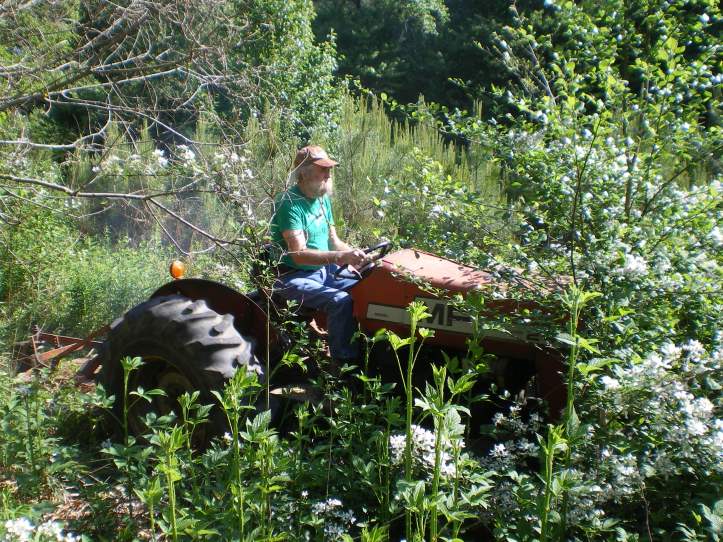My father-in-law has lived on the same plot of farmland in northeast Georgia since he was 5 years old (he turned 60-something this year) and he knows everything about it. He is an amateur entomologist, biologist, agronomist, plant pathologist, and botanist. As part of his culture he was taught to pay attention to the world around him. He knows about the cycles of the populations of insects that have occurred in his fields for the last 50 years—more than one would find in any scientific database. As a result he can describe the population changes of insects that have occurred in response to drought, temperature changes, and invasive species that a scientist coming from anywhere else stepping into that field for the first time would not know.

When we first met, he described the invasion and subsequent demise of Japanese beetles that he had observed over the last 20 years. During the summers of the 1980s, Japanese beetles would descend on the grape vines growing around the farm and my father-in-law would spend hours each afternoon in the hot summer Georgia sun collecting and drowning Japanese beetles in milk jugs of soap water, but much to his dismay, more beetles would return the next day. This futile daily ballet of beetle collecting continued for YEARS until the arrival of the fire ant to north Georgia in the 1990s. My father-in-law explained that when fire ants became established at his farm, the Japanese beetles virtually disappeared. He speculated that the voracious fire ants were eating the Japanese beetle larvae, thus providing ecosystem-wide control of an invasive herbivore. His studies were not a traditional scientific study but scientific observations none the less.

In the modern world we often take our own intuition, background, and observations for granted—leaving aside the cultural or observational knowledge like that of my father-in-law. Our science is seen as culturally neutral, data and instrument driven. Yet if we really integrate our science into our culture and pay attention to those who have conducted decades of observation we could have a better interpretation of the world around us—potentially gaining new insights into our world.
I recently attended the Ocean Sciences meeting in Hawaii and the speaker at the opening ceremony was Dr. Elizabeth Kapu’uwailani Lindsey. She is a fellow of the National Geographic Society who studies cultural anthropology, and more specifically, native wayfinders.
While modern sea voyages rely on GPS satellites, the wayfinders of the Pacific Ocean have found their way across vast stretches of water without using complicated instruments or maps. The native peoples’ knowledge comes from their own scientific findings based on their decades of experience on the oceans. Lindsey’s main point was that in this modern world we are losing such cultures and ways of doing science and learning about our world.
There is a movement in science to use community-based research as a way to use the collective viewpoints of citizen scientists. For example some of the major changes occurring as a result of global warming are noticed by people living in the arctic or in coastal communities. There are several efforts to use the knowledge and insight of people living in those areas to supplement scientific data and even “Boot Camp” experiences for scientists to interact with indigenous people in Australia to infuse native knowledge into research.
So how do we apply this to something like a Center involved in nanotechnology you may ask? One may think that it’s not a type of science that lends itself to cultural insight. Though we differ from my father-in-law in that we’re not conducting our science in a natural area where we have grown up, we are similar because each of the 20 or so scientists working in our Center brings his/her own unique cultural background to the table. These differing backgrounds can dramatically affect the questions we choose to ask and how we observe and interpret changes in our experiments.
What aspect of an experimental result do you think is most important? What do you want to know about it? How will we find out? These are all questions that scientists face every day. Though data and rational arguments are of utmost importance, these more values-laden questions can play pivotal roles in guiding our science.
One of the missions of our Center is to represent and foster the growth of a diverse group of scientists. We have weekly meetings of all the Center scientists, and we do our best to have these serve as forums for the consideration of ideas from all of our scientists. Annual anonymized climate surveys as well as frank discussions of females’ experience in traditionally male-dominated fields (our Center is composed of roughly 50% females) are two of the ways we try to make this happen. By encouraging equality in the consideration of ideas, we can enable the diverse experiences and ways of thinking to move our science forward.

Further Exploration
Healthy Habitats Have Native Plants activity
Insect Collection activity
For the Birds: Environmental Effects on Population activity
Measuring Biodiversity activity
